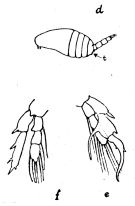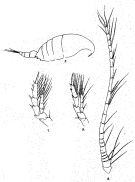|
|
 |
|
Calanoida ( Order ) |
|
|
|
Diaptomoidea ( Superfamily ) |
|
|
|
Centropagidae ( Family ) |
|
|
|
Centropages ( Genus ) |
|
|
| |
Centropages trispinosus Sewell, 1914 (F,M) | |
| | | | | | | Ref.: | | | Sewell, 1914 a (p.223, Descr.F, figs.F); Kasturirangan, 1963 (p.32, figs.M); Vervoort, 1964 b (p.309); Saraswathy, 1966 (1967) (p.78, Rem.F); Silas, 1972 (p.648); Ohtsuka, McKinnon & al., 2003 (p.75: Rem.) |  issued from : Kasturirangan L.R. in Publs Counc. Scient. Indust. Res. India, 2. [Fig.27, p.33]. Male: d, habitus (lateral view, left side) (t: three small teeth-like); e, P5 (right, posterior face).
|
 Issued from : R.B.S. Sewell in Spolia Zeylanica, 1914, 9. [Pl.XVIII, Figs.5-8]. Female (from Gulf of Mannar): 5, habitus (lateral right side); 6, A1; 7, P2; 7, P5. Nota: Proportional lengths of cephalothorax and abdomen 3:1. Head and 1st thoracic segment separate, 4th and 5th separate. Posterior thoracic margin rounded, armed 3 short spines situated rather towards the ventral side. Rostrum consists of 2 slender processes. Proportional lengths of urosomites and furca 4:3:2:2. Genital segment somewhat barrel-shaped, and has a rounded swelling on the dorsal aspect. A1 21-segmented (segments 2-4, 8-9, 24-25 fused). P5: both rami 3-segmented; exopod 1 bears a marginal spine, but has no internal seta; exopod 2, in addition to the single external marginal spine, bears the usual spine on its inner border, this spine is long and has somewhat swollen base; it tapers gradually to a fine point and bears no teeth on its surface; exopod 3 has 2 marginal spines and a finely serrated end-spine; the endopodite reaches to the level of the joint between exopods 2 and 3; endopod 1 presents a well-marked rounded swelling at its distal external angle. The remaining appendages appear similar to those of C. alcocki but the serrations on the terminal spines of the swimming feet are not so coarse and are less widely separated.
| | | | | Compl. Ref.: | | | Sewell, 1932 (p.232); 1948 (p.323); Krishnaswamy, 1953 (p.121); Ganapati & Shanthakumari, 1962 (p.8, 15); Goswami & al., 1977 (tab.3); Goswami & Selvakumar, 1977 (tab.1, 2); Madhupratap & Haridas, 1986 (p.105, tab.1); Dalal & Goswami, 2001 (p.22, fig.2); Rakhesh & al., 2006 (p.93, Table 2, spatial distribution); | | | | NZ: | 1 | | |
|
Distribution map of Centropages trispinosus by geographical zones
|
| | | | | | | Loc: | | | India (S, W), G. de Mannar, Lawson's Bay, Madras, Bay of Bengal | | | | N: | 7 (Indian: 7) | | | | Lg.: | | | (82) F: 1,4; (334) F: 1,2-1; M: 1; (530) F: 1,5; M: 1,5; (795) F: 1,6-1,4; M: 1,025; {F: 1,00-1,60; M: 1,00-1,50} | | | | Rem.: | brackish.
Perhaps synonym of Centropages brevifurcus.
For Ohtsuka & al. (2003, p.75), the body length, the posterior prosomal corner, and P5 of the female of C. trispinosus Sewell, 1914, are similar to those of female C. brevifurcus, but the 3rd exopodal segment of P5 is relatively much shorter in C. trispinosus (ca. 1.4 times as long as the 2nd segment) than in C. brevifurcus (1.7). In addition, the inner process of the 2nd endopodal segment of female P5 of C. trispinosus is slender and pointed at the apex and lacks serration along posterior margin. The genital compound somite carries a dorsal swelling only in C. trispinosus. Pending a complete redescription of both sexes, possibility cannot excluded that this species is identical to C. brevifurcus. | | | Last update : 31/12/2014 | |
|
|
 Any use of this site for a publication will be mentioned with the following reference : Any use of this site for a publication will be mentioned with the following reference :
Razouls C., Desreumaux N., Kouwenberg J. and de Bovée F., 2005-2025. - Biodiversity of Marine Planktonic Copepods (morphology, geographical distribution and biological data). Sorbonne University, CNRS. Available at http://copepodes.obs-banyuls.fr/en [Accessed July 03, 2025] © copyright 2005-2025 Sorbonne University, CNRS
|
|
 |
 |





